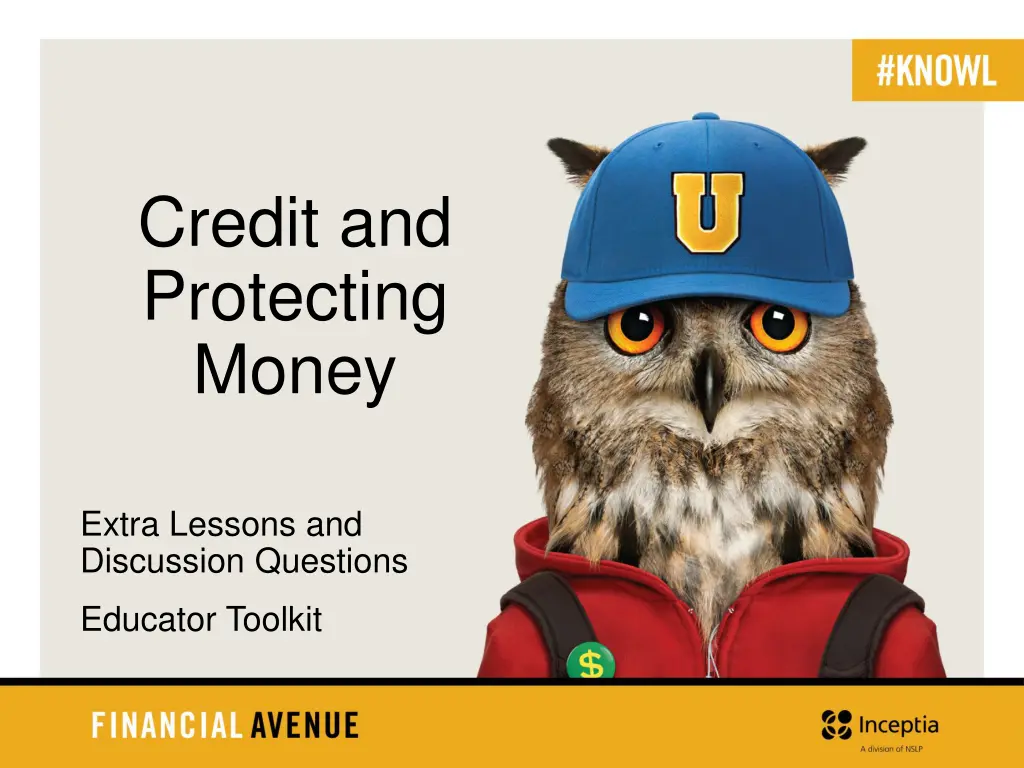
Understanding and Managing Your Credit History
Explore the essentials of financial literacy in "Understanding and Managing Your Credit History" and learn how to review, repair, and protect your credit. Discover the importance of good credit, how to resolve errors, and steps to build or repair your credit score effectively.
Download Presentation

Please find below an Image/Link to download the presentation.
The content on the website is provided AS IS for your information and personal use only. It may not be sold, licensed, or shared on other websites without obtaining consent from the author. If you encounter any issues during the download, it is possible that the publisher has removed the file from their server.
You are allowed to download the files provided on this website for personal or commercial use, subject to the condition that they are used lawfully. All files are the property of their respective owners.
The content on the website is provided AS IS for your information and personal use only. It may not be sold, licensed, or shared on other websites without obtaining consent from the author.
E N D
Presentation Transcript
Credit and Protecting Money Extra Lessons and Discussion Questions Educator Toolkit
Credit and Protecting Money How do you 1. Understand and manage your financial story and credit history? 2. Repair or improve your financial story and credit history? 3. Protect your financial information from identity theft and consumer fraud?
Todays Lesson Managing and Protecting Your Financial Story 1. Review your credit: Understand your credit history and review it for errors and weak spots. 2. Build and repair credit: Build a credit history and repair damaged credit. 3. Protect your information: Take precautions to avoid identity theft and consumer fraud. Take steps to recover if you do become a victim.
1. Review Your Credit: Review REVIEW AND DISCUSS CREDIT AND PROTECTING MONEY SECTION 1: UNDERSTANDING YOUR CREDIT HISTORY Recognize the importance of good credit history. Identify the components of a credit report and common credit report errors. Explain the steps necessary for resolving errors on a credit report.
1. Review Your Credit: Discuss Q: What s in your credit history? Brainstorm: What all is included in your credit history? What s not included? If someone was deciding whether or not to lend you money based on your credit history, which things would matter most? Which would matter least? Reflect and Discuss: Why do you think good credit history is important? Why would you want to make sure your credit history is error free?
1. Review Your Credit: Exercise Q: What do I look for on my credit report? Review and Brainstorm: Take a look at the sample credit report here. What sections should you pay attention to? Where should you check for errors? Reflect and Write: What steps will you take to check the health of your credit history? Write them down.
2. Build and Repair: Review REVIEW AND DISCUSS CREDIT AND PROTECTING MONEY SECTION 2: BUILDING AND REPAIRING CREDIT Elements of a credit score. The financial behaviors that influence a credit score. How to build or repair a credit score.
2. Build and Repair: Discuss Q: What impacts my credit score? Discuss: On a scale of 1-5 (1 being the lowest, 5 being the highest), how do each of these impact your credit score? o Length of Credit; New Credit; Amounts Owed; Payment History; Types of Credit Brainstorm: If you wanted to improve your credit score, what would you start doing first? What would have the biggest impact?
2. Build and Repair: Exercise Q How can I build or repair my credit? Brainstorm: What are all the ways you can boost your credit if it s low? What are all the ways you can build your credit if you don t have any? Reflect and Write: Based on this list, what s one thing you could do to help your credit? Write it down.
3. Protect Your Info: Review REVIEW AND DISCUSS CREDIT AND PROTECTING MONEY SECTION 3: PROTECTING YOUR FINANCIAL INFORMATION Identify common identity theft and consumer fraud schemes. Protect yourself from identity theft. Resolving identity theft or consumer fraud if it does happen.
3. Protect Your Info: Discuss Q: What is identity theft and consumer fraud? Brainstorm: What kinds of identity theft or consumer fraud have you heard of, either personally or in the news? How do thieves in these situations take advantage of someone to steal their identity and/or money? Reflect: What would you do to protect yourself from these kinds of scams?
3. Protect Your Info: Exercise Q: What is putting me at risk for identity theft or consumer fraud? Brainstorm: How would you reinforce your life to avoid identity theft and consumer fraud? What would you do with your financial accounts and information, credit history, web access and logins, etc. to protect yourself? Reflect and Write: What are three steps you can take this week to protect yourself? Write them down.
Take Action Check your credit report annually at www.annualcreditreport.com. Check your bank and credit card statements for suspicious activity. Strengthen the passwords on your accounts. Protect and/or shred any documentation that an identity thief could use to their advantage. Report any identity theft or consumer fraud at www.ftc.gov.
Wrap-up Managing and Protecting Your Financial Story 1. Review your credit: Check your credit history annually and review it for errors. 2. Build and repair credit: Build and repair your credit history by making on-time payments and keeping your debt low. 3. Protect your information: Protect your financial information and strengthen your passwords to avoid identity theft and consumer fraud.
